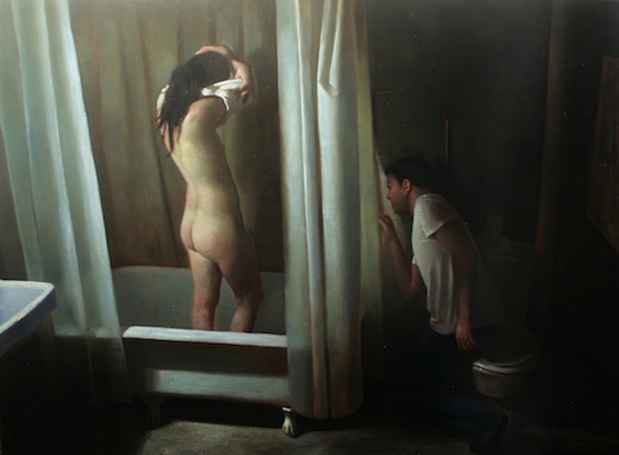“Beyond The Threshold” Exhibition
Mark Miller Gallery

This event has ended.
The interior: a subject that first surfaced in 17th century Holland, and that abandoned the exactitude of religious painting in favor of something more elusive: the inhabitable space. More than merely domestic landscape, the subject captures the unseen motion of sentient beings; more than a backdrop for a play, it is the narrative of the stage itself, a play where the stage is the protagonist. Beyond the Threshold is a window into such interiors: vacant desolate rooms, cavernous industrial basements, private washrooms, and intimate living quarters.
Dina Brodsky’s beautifully painted interiors whisper of mysteries and secrets. One imagines the life that made these forgotten spaces as they are, that their thick air holds ghosts and echoes of something important. An immigrant from Soviet Belarus, Dina is no stranger to departure from, and loss of home; her paintings reflect the glimpse of life in the decaying and abandoned crevices of her private universe.
Tun Myaing’s unapologetically miniature format invites the viewer to closely examine the otherwise impersonal and forbidding interiors of his paintings. In the painting The Boiler Room, Tun’s fine technique and meticulous attention to detail compels the viewer to enter the interior, while simultaneously pushing her away with the heavy impact of old metal. There is no innocence or sentimentality in Tun’s compositions; his interiors intrigue the viewer as they hold fast to the unanswered questions within their depths.
Luis Borrero’s paintings retain their absolute stillness even as they allow for the presence of the human figure. An inadvertent voyeur, the viewer finds herself imposing on a private moment between a human being and the surrounding silence. In Man In Tub and Encounter there is a tangible boundary that separates the viewer from an otherwise intimate moment, a dimly lit atmosphere that converges around the naked figure, and a sense of both solitude and a probing, halting sexuality.
Amber Lia-Kloppel’s work also explores the relationship of space and voyeurism. Depicting mainly women, classic targets of the voyeuristic gaze, she uses physical structures to emphasize the viewer’s and subject’s solitude – even as the subject turns her head to gaze back at the viewer. In the painting Peephole, Amber emphasizes the physical separation of the viewer and the figure; the door reasserts the privacy of the figure, separating her from the viewer, and linking both to their respective spaces.
The four artists in this exhibition make work that both invite and forbid the viewer into entering their worlds, leaving them at the threshold: allowed a glimpse of the narrative within, but as a voyeur, not a participant. In a feat of visual alchemy they extract volumes out of silence, and take us along to participate in the stillness of the spaces they visited, observed, and quietly recorded.
Media
Schedule
from September 07, 2014 to October 05, 2014
Opening Reception on 2014-09-07 from 18:00 to 21:00